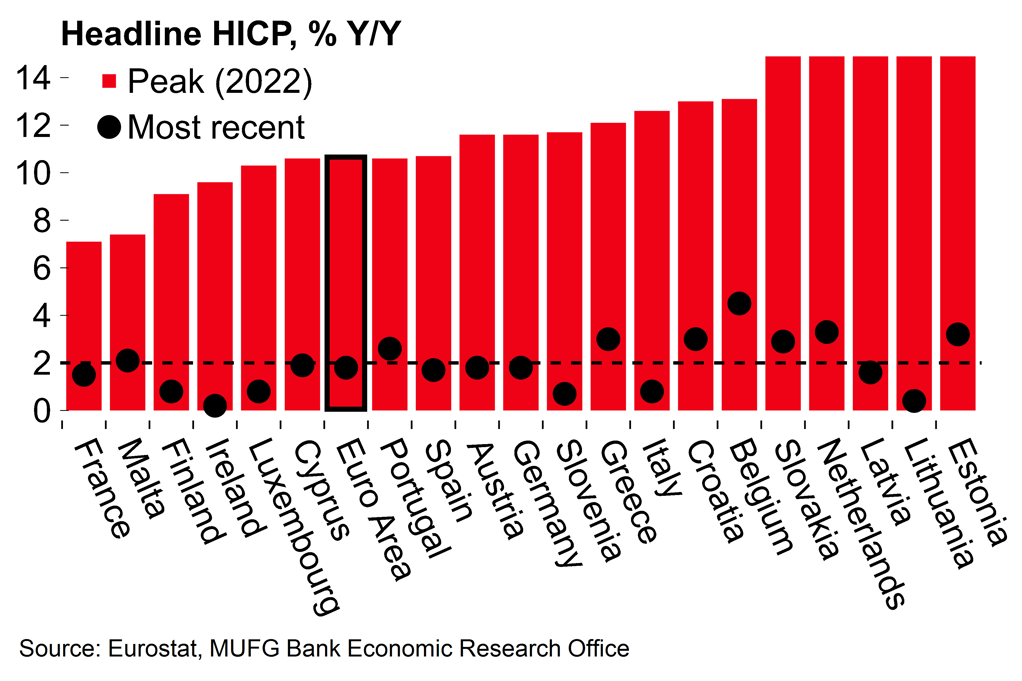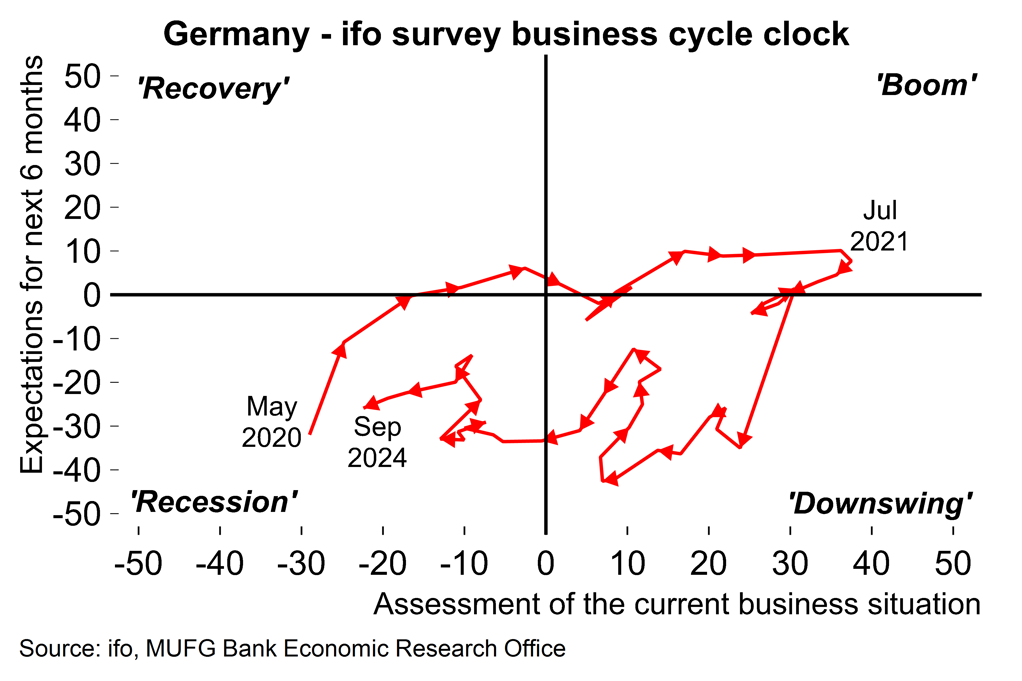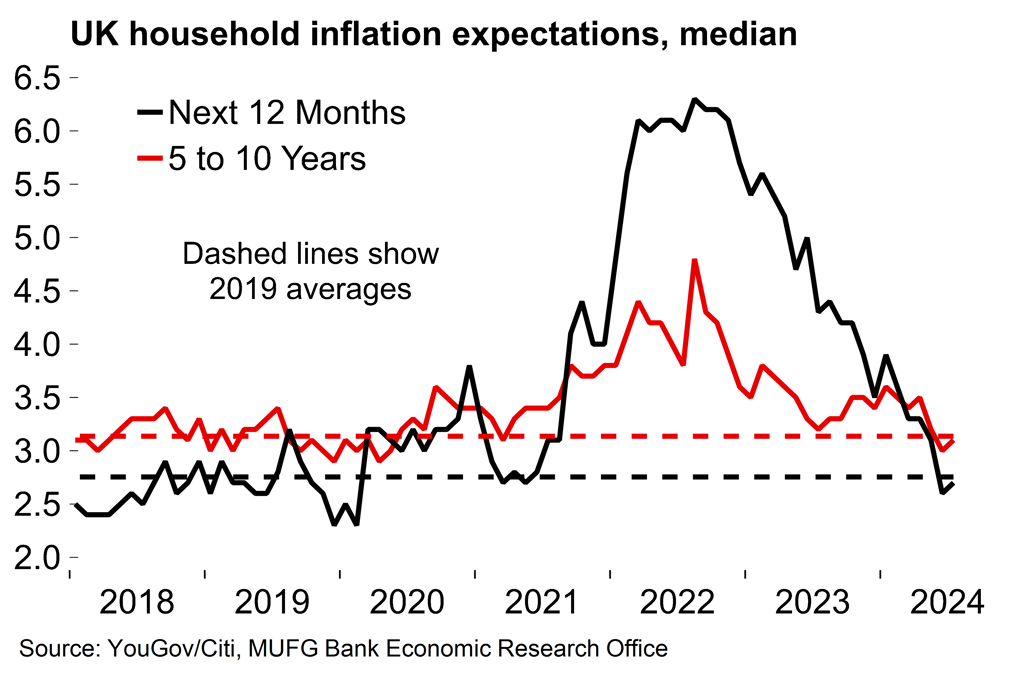- The ECB and the BoE initially embarked on what seemed a default pace of cuts at quarterly projection meetings. Comments this week from officials suggest that both central banks are now poised to go faster. With the dust settled on the Fed’s big initial move policymakers may believe that hints at recalibration on this side of the Atlantic come with less risk of being misinterpreted by market participants.
- For the ECB, with its data-dependent setting, faster easing clearly makes sense now. The euro area data flow has been almost wholly supportive of more easing with inflation now below target and no signs of any improvement in the demand backdrop. The ECB would risk losing credibility if it didn’t respond to that – there is no reason to wait until December. That said, the message is likely to be one of an orderly recalibration in response to incoming data rather than a sign of an urgent need to make up for lost ground.
- The BoE’s apparent shift, with governor Bailey talking about the possibility of more “activist” and “aggressive” easing, is harder to understand. At the policy meeting just two weeks ago the message was one of a “gradual” approach. The flow of data since then has been mixed from a monetary policy perspective, which raises questions about the BoE’s reaction function. We had assumed that any pivot in messaging would come closer to the Budget once there was more clarity about the extent of near-term fiscal consolidation. In terms of the outlook, a November cut seems essentially guaranteed at this point but, despite the obvious significance of Bailey’s remarks, a back-to-back move in December is not yet a done deal. Recent comments from the more hawkish MPC members suggest a move, if there is one, would come with another tight vote split.
The ECB looks set to go back-to-back
The ECB cut rates at its last meeting in September. There was no fresh guidance – the message was that the flexible, data-dependent approach would continue. That said, Lagarde did acknowledge that the gap until the next meeting (17 October) was relatively short at just five weeks. She also highlighted that the September inflation rate was likely to fall, before rising again later in the year. The message seemed to be: yes, we are data-dependent, but don’t expect us to react suddenly to a handful of incoming figures.
That tune seems to have changed. On Monday, Lagarde spoke to a European Parliament Committee and acknowledged that recent developments strengthen the ECB’s confidence that “inflation will return to target in a timely manner” and that policy makers will “take that into account” at the next meeting. Executive Board member Isabel Schnabel, who tends to be a more hawkish voice, said that a sustainable return of inflation to target “is becoming more likely” this week, with that sentiment echoed by various Governing Council members recently as well. The September meeting minutes, released next week, could lay some more groundwork for quicker easing.
So, with less than a week until the pre-meeting quiet period, it does seem as though there has been a dovish shift in the ECB’s thinking. Market pricing around the chances of an October rate cut has moved accordingly, from 25% to 90%+ in less than two weeks. Our view is that the ECB would risk losing credibility if it didn’t act and there doesn’t seem to be any reason to wait until December. If a central bank has a data dependent approach then expectations can change quickly and the data flow over the last few weeks has been almost entirely supportive of further easing.
This week saw headline HICP inflation fall below target in September, to 1.8%, with both core and the services components edging lower. That left Q3 average inflation a tick below the ECB’s September projection. Meanwhile, it’s becoming ever more apparent that the euro area economy has lost momentum. The composite PMI slipped below the breakeven mark last month, for the first time since February. The German economy, which may well slip into a technical recession in Q3, is still acting as a brake on overall euro area activity. We said at the time that the ECB’s latest euro area GDP projection (0.8% in 2024) looked optimistic and that sense has only increased (we have 0.7% and acknowledge risks are tilted to the downside).
Chart 1: Inflation is now below or close to target in most euro area countries

Chart 2: No sign of any improvement in German business sentiment

On the other hand, recent geopolitical developments clearly pose upside risks to inflation with the Brent spot now around 78 USD, 7.5% above the September average price. It’s worth noting that, after the subsequent slide in prices, this is still slightly lower than the spot at the time of the cut-off for the ECB’s latest projections (16 August). Those projections include alternative energy price paths (see Section 6 here), which may become increasingly relevant. The ECB estimates that a 19% energy price shock in 2025 relative to the baseline would see headline HICP inflation at 3.0% (baseline: 2.2%), with minimal impact on growth.
Would policymakers be comfortable looking past this sort of supply shock to energy prices? Well-anchored inflation expectations will provide some comfort: medium-term expectations edged lower in the latest release to 2.3%. But the risk that expectations would become less well-tethered following a fresh rise in inflation is likely to be higher after consumers’ experience of price pressures in recent years. The labour market backdrop is still relatively healthy – especially for the services sector in southern euro area countries – which also promotes caution.
So, overall, it seems that the ECB is now shifting to back-to-back cuts but will likely stress that this is an orderly recalibration in response to incoming data rather than a sign of an urgent need to make up for lost ground. Despite recent gloom on the growth front there are still risks around the inflation outlook and policymakers will want to retain a degree of flexibility over the easing schedule.
Is the BoE also poised to step up the pace?
There was also a significant change in messaging from the BoE this week. After the initial cut in August, policy was left unchanged at the recent September meeting. Overall it was a somewhat hawkish update, especially in the context of the Fed’s big move the day before – our takeaway (see here) was that UK policymakers did not show any signs of sharing the Fed’s urgency to ease policy. This pointed to a quarterly pace of easing, probably at projection meetings (i.e. November, February), but that may have changed. In a significant intervention this week, governor Bailey said that the BoE could be “a bit more aggressive” and become “a bit more activist” in its approach to cutting interest rates.
Now, to our minds, the ECB’s apparent shift in communication makes sense. The ECB has emphasised its data-dependent approach – and the data has supported more easing. The BoE, on the other hand, isn’t devoutly data dependent and has set out some guidance about the pace of future easing. The statement from the meeting – just two weeks ago – noted that “a gradual approach to removing policy restraint remains appropriate”. Bailey, at the time, also said separately that it was likely to be a “gradual path”.
What’s changed since then to provoke discussion of more “aggressive” easing? Data in the UK has been not been uniformly supportive of a pivot in the way that it has been for the ECB. Yes, there was weakness in consumer and business surveys, but this is likely related to uncertainty around the upcoming Budget (30 October) and sentiment could easily rebound in November if tax tweaks aren’t as painful as feared (more on this below). There was a downward revision to Q2 GDP (0.6 to 0.5% Q/Q) but this was mostly due to changes in the estimate of government spending – in terms of private sector demand, business investment was actually revised up and consumer spending left unchanged. More recently, retail sales in August came in strong (1.0% M/M), reducing fears around Q3 GDP after the flat monthly output figure for July. The BoE’s DMP survey (here) was a mixed bag with hints of more labour market slack but unchanged expectations for price and wage growth.
Chart 3: UK inflation expectations have normalised

Chart 4: Relative to pre-pandemic rates both the ECB and the BoE tightened by more than the Fed

To be sure, there are arguments for a faster pace of easing. The data has generally been moving in the right direction from a monetary policy perspective. Any fears around an overheating economy after strong growth in H1 have dissipated after clear signs that momentum is now weaker (we still judge the UK economy to be in reasonable shape with growth likely to hover around potential as consumer conditions remain supportive). As with the euro area, inflation expectations seem well-anchored, which will go some way towards easing concerns around the impact of higher oil prices. Meanwhile, a smaller share of floating rate mortgages and healthier household balance sheets has probably weakened the consumer cash-flow channel of monetary policy, which would call for more forceful easing.
But we had assumed that any pivot to faster easing would come a little later. The Autumn Budget (30 October) seemed like an obvious juncture for a change in communication from the BoE as there will then be more clarity about the extent of fiscal consolidation coming down the track. The current BoE projections from August do assume some fiscal tightening, but the government may go further. The chancellor is poised to implement a range of tax rises to balance day-to-day spending requirements and there is high uncertainty about the scope and timing of these. The pre-election commitment from Labour to not change income tax, corporation tax, VAT or employee National Insurance (which together account for the bulk of revenues) has left the government fenced in and forced to target smaller amounts from other sources, and any behavioural changes in response to these will be hard to model.
At the same time, the government seems set to carve out more space for investment spending through tweaks to its fiscal rules. That is something else that the BoE will be watching with interest. A significant increase in capex over the longer-term would add further uncertainty to estimates of ‘neutral’ and bolster arguments for a higher terminal rate or at least a more cautious approach to easing as upper estimates of that rate are approached.
On the immediate outlook, the next cut in November is consistent with the guidance from the last meeting and seems almost certain as things stand. Recent comments suggest that there will be broad support for it even among more hawkish members of the MPC. Indeed, after the finely balanced 5-4 split in August for the initial cut, it is plausible that it could even be a unanimous decision. However, any cut in December may well come with another tight vote. Today Huw Pill, the BoE’s chief economist, suggested there’s a need for caution which “points to a gradual withdrawal of monetary policy restriction”.
Yesterday’s comments from Bailey may suggest he thinks it may break in favour of another cut but, as we set out above, there is now some confusion about the BoE’s reaction function. Last month it’s possible that the BoE felt the need to dial back any gradual dovish adjustments in its guidance after the Fed’s 50bp rate cut to make it clear that there was no intention to be quite so proactive. But now that the dust has settled on the Fed’s big move it seems that policymakers may be more content to hint at some recalibration on this side of the Atlantic.
GDP & CPI forecasts


